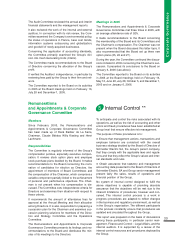APC 2005 Annual Report Download - page 45
Download and view the complete annual report
Please find page 45 of the 2005 APC annual report below. You can navigate through the pages in the report by either clicking on the pages listed below, or by using the keyword search tool below to find specific information within the annual report.
43
All industrial property information for the main Group
subsidiaries is transmitted to this team, which is
responsible for managing and protecting these intan-
gible assets around the world. The same procedure is
followed for trademarks.
Purchases
A key process in Group operations, purchases repre-
sent around 40% of consolidated revenue.
Rules governing purchases mainly concern Purchas-
ing department organization and procedures, relation-
ships between buyers and suppliers, levels of signa-
ture authority, and compliance with environmental
standards. Internal audit plans for individual sub-
sidiaries or units systematically cover the Purchasing
department and include productivity and cost of non-
quality analyses, compliance reviews and analyses of
the supplier portfolio.
Internal control procedures
related to the preparation and
processing of accounting
and financial information
Transition to IFRS
The consolidated financial statements for all fiscal
years commencing on or after January 1, 2005 are
prepared in accordance with International Financial
Reporting Standards (IFRS), to comply with European
Union regulation 1606/2002.
The accounting rules and procedures followed at the
level of the subsidiaries and at Group level have been
revised and modified to comply with the IFRS adopt-
ed by the European Union.
A special note to the financial statements presenting a
reconciliation of the 2004 French GAAP accounts to
the 2004 IFRS accounts appears in the appendix to
the annual financial statements.
Internal control procedures
to confirm the existence and value of assets
and liabilities
Internal control procedures generally consist of defin-
ing levels of responsibility for authorizing and checking
transactions, and segregating tasks to help ensure
that all transactions are justified. In addition, integrat-
ed statutory and management reporting systems have
been developed to guarantee the completeness of
transaction data recorded in the accounts.
Each subsidiary is responsible for implementing proce-
dures providing an adequate level of internal control.
Operating Division management teams assist the
units in this process and represent a first level of con-
trol in the application of procedures.
Intangible assets
The process for valuing software and product develop-
ment costs is designed to monitor and analyze
expenses, identify the portion of those expenses that
meet the definition of an asset and may be capitalized,
and track the asset’s use over time. IT systems have
been deployed to track project development costs and
measure the profitability of new products more accu-
rately.
The carrying value of trademarks is determined based
on an assessment of the economic value of the under-
lying business at the time of acquisition and on an
independent valuation of the trademark.
In accordance with IFRS, goodwill and non-amortized
intangible assets recognized during acquisition are
tested half-yearly and yearly to ensure that the recov-
erable amount is higher than the carrying amount.
Property, plant and equipment
Land and buildings are tracked by the Property
department and stated at historical cost net of accu-
mulated depreciation and any impairment losses.
Manufacturing assets are tracked by the Globalization
& Industry department. Property, plant and equipment
are recognized in the accounts on the basis of title
deeds, an invoice or a financial lease accompanied by
documentary evidence that the asset has been put
into service.
Investments
Investments in consolidated companies and available-
for-sale financial assets are tracked and verified by the
Finance and Control – Legal Affairs Department.
Inventories
Inventories are verified at least once a year in each
subsidiary through physical inventories or cycle
counts. Inventories are written down to net realizable
value where appropriate.
Trade receivables
When sales are recorded in the accounts by the sub-
sidiaries, this automatically generates an entry in a
trade receivables account. Receivables are valued
and – where appropriate – written down by the sub-
sidiaries in accordance with Group policies.
A credit management charter prepared by the Cus-
tomer Credit Department provides guidelines for new
customer acceptance, credit insurance, reminder
notices and unpaid bill collection procedures.
Tax assets and liabilities
The subsidiaries are responsible for calculating,
accruing and managing their taxes, except in some
cases where the subsidiary concerned is a member of
a tax group.
The Tax unit within the Finance and Control – Legal
Affairs Department reviews the current tax charge in
countries that represent a significant portion of the
Group’s total tax charge. The Tax unit is also respon-
sible for overseeing the resolution of tax claims.
Corporate Governance
























